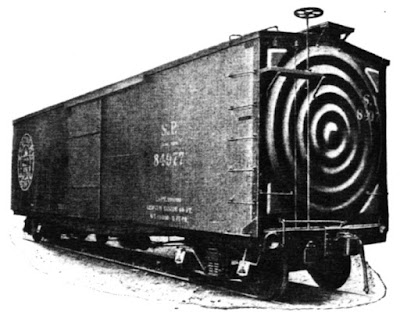Many of us who are model builders at heart hate to face the fact that some interesting and desirable models are simply of too early a period to make sense. If you model, say, 1953, as I do, you may love diamond-stack 4-4-0 locomotives but they are just not going to be credible on the SP in California in 1953, The same goes for early freight and passenger cars, even structures which may no longer exist in 1953.
But in some situations there can be an “out” for the nostalgic modeler (relative to the chosen modeling period, that is). Like most railroads, Southern Pacific did roster a considerable fleet of maintenance cars, some of them naturally purpose-built, but many merely hand-me-downs from the fleet of revenue freight (and passenger) cars. So clearly one way to be able to both build and use models of earlier eras would be to see how they were used in Maintenance of Way (MW) service.
For me, one such very attractive and interesting group of “too old” prototype freight cars comprises the Harriman car designs, so called because they were built under Common Standards for both Union Pacific and Southern Pacific during the Harriman Lines era. Most of these cars had pressed-steel underframes and wood-framed superstructures, so their life would necessarily be limited by survival of the superstructure. And indeed, though many survived through the 1920s after construction during 1906–1910, they began to be scrapped in quantity after 1930. No doubt the Mechanical Department and the shops were unwilling to rebuild wood superstructure framing in kind by that date, but such a car could be refurbished and perhaps modified as needed for MW service.
I have already talked about this process in describing my use of a Westerfield kit for the early PFE refrigerator Class R-30-2 (kit 1802). I helped Al with prototype information in developing this kit, and in return he sent me a free kit. Well, this class of cars was long gone in revenue service by 1953, but I did know the SP had bought ten of these cars in the 1930s, so built the kit and decorated it as one of those SPMW cars. I showed the result in a prior post (at: http://modelingthesp.blogspot.com/2013/04/modeling-some-sp-mow-cars-part-2.html ).
Another example of this process was supplied in another post, in which I used the Westerfield kit for Harriman Class B-50-2 to model an MW car, SPMW 2621 (that post is at this link: http://modelingthesp.blogspot.com/2013/03/modeling-some-sp-mow-cars.html ). As explained in that post, the car number is that of an actual B-50-2 car which was converted to MW service. A photo of the completed car is in that post also.
But I wanted to do another such car for MW service, a desire stimulated by the beautiful kit Al Westerfield produced of the one and only SP car which received a Van Dorn pressed steel end (Westerfield kit 1761). Here is a prototype photo of this unique car.
This isn’t a great image, but shows clearly the B or brake end of this one car, SP 84977. Below is a view of the A end, interesting because of the lumber doors which had to be fitted to the shape of the end stamping.
Note how the end lettering is applied over the ridges in the stamping. The car itself was built in August 1906, and was chosen in 1910 for a retrofit of this newly manufactured car end. The ends were applied in May, 1910, and the car survived in revenue service until it was declared “worn out” on March 29, 1939 at Los Angeles. Though this probably meant the car was scrapped at that time, it is also possible that it was transferred to MW service instead. I don’t find this car number, SP 84977, as a former car number in any MW roster, but these rosters did come and go, so I have decided to believe the car was so converted, at least for a time. Certainly if it survived 1939 in any form, it would have to have been as MW.
In particular, with Westerfield’s superb molding of this remarkable end, I can arrange for SP 84977 to live on in MW service, though of course with an MW number. Here are two photos of the model, assembled by Dennis Williams and lettered by me, first showing the well-rendered A end. I applied the end lettering as in the prototype photos. The sides and ends are not yet weathered.
The B end lacks the doors, but has all the brake step and handbrake attached over the ribs, in some ways even more complex than the A end. You can see those details here.
Though the prototype of this Van Dorn car may have been scrapped by my modeling year of 1953, I have kept it alive in MW service, as just another roadway box car. I will discuss in a future post the MW and operation side of the modeling.
Tony Thompson




Tony, did the van dorn A end lower lumber door open as a two piece horizontal set of doors?
ReplyDeleteTony, did the van dorn A end lower lumber door open as a two piece horizontal set of doors?
ReplyDelete